The MSI MEG X570 Ace Motherboard Review: Ace in the Hole at $369
by Gavin Bonshor on July 18, 2019 11:00 AM EST- Posted in
- Motherboards
- AMD
- MSI
- AM4
- Zen 2
- Ryzen 3000
- X570
- MEG
- X570 Ace
- 3700X
- Ryzen 3700X
Visual Inspection
As it currently stands, the X570 Ace is the part of MSI's MEG branded enthusiast gaming range. The MSI MEG X570 Ace also follows a different design path to almost all of its launch day X570 competition, with an all-black PCB with gold and black designs on all of the heatsinks. This represents and acknowledges AMD's 50 year anniversary, although it isn't specified on the packaging.
In terms of PCIe, the MSI MEG X570 Ace has two full-length PCIe 4.0 slots from the CPU, which run at x16 or x8/x8, and a final full-length PCIe 4.0 x4 slot from the chipset. Also present is two PCIe 4.0 x1 slots, On the board are seven 4-pin fan headers, an LED Debugger located below the SATA ports, a power button, a reset switch, and an MSI Boost dial which allows users to use MSI's pre-defined overclocking profiles without entering the BIOS.
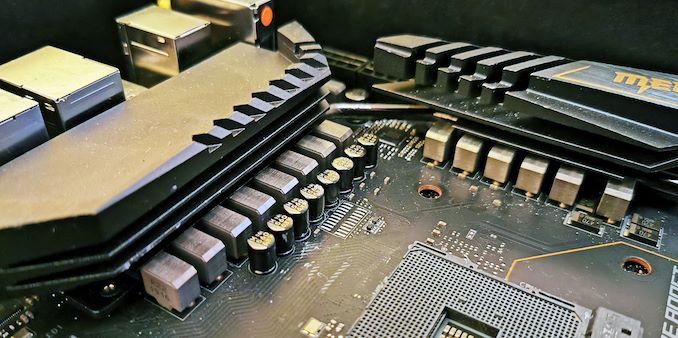
The MSI MEG X570 Ace power delivery heatsink without the rear panel cover
Unlike a lot of other ATX sized X570 motherboards, the X570 Ace features only four SATA ports with support for RAID 0, 1, and 10 arrays. Sandwiched between the full-length PCIe 4.0 slots are three PCIe 4.0 x4 M.2 slots which have their own individual Lightning Gen4 M.2 heatsink. For the memory, the MSI MEG X570 Ace has four memory slots with support for DDR4-4533 and up to a maximum capacity of 128 GB. All of MSI's X570 product stack has been qualified for use with 32 GB UDIMMs with the Samsung 32 GB DDR4-2666 supported out of the box.
As with the MSI MEG X570 Godlike, the MEG X570 Ace does include a fair amount of plastic on the rear panel cover and around the X570 chipset heatsink. This is more forgivable on a non-flagship model such as this, and although it shouldn't affect thermal performance due to the actively cooled chipset heatsink, more metal would give a more premium feel. Located around the edge of the PCB are seven 4-pin PWM fan headers which are divided into one for a CPU fan, five for system fans, and a single 4-pin header dedicated for water pumps.
The MSI MEG X570 Ace sits in third position in MSI's stack; only the X570 Godlike and X570 Creation offering a bigger feature-set and better-equipped power delivery. On the MEG X570 Ace, the PWM controller of choice is the International Rectifier IR35201 which is operating in 6+2 mode with the CPU VCore element opting for 12 x IR3555 60 A power stages which are doubled up with 6 x IR3599 doublers. Providing power to the CPU is two 8-pin 12 V ATX CPU power inputs.
The VGT/SoC is using two individual IR3555 60 A power stages to make up the 6+2 design. Keeping the power delivery cool is a large aluminium heatsink which is connected to the actively cooled X570 chipset heatsink by a single heat pipe. The X570 chipset heatsink fan is powered by MSI's Zero Frozr design which makes it semi-passive with the fan only ramping up when the chipset gets warm, and with integrated PCIe 4.0 lanes, this is sure to add extra work for the heatsink to deal with when compared with previous variants of AMD's AM4 chipsets.
Over on the rear panel, the MSI MEG X570 Ace is three USB 3.1 G2 Type-A, a single USB 3.1 G2 Type-C, two USB 3.1 G1 Type-A, and two USB 2.0 ports. Onboard audio-wise, there are five 3.5 mm audio jacks and a S/PDIF optical output powered by a Realtek ALC1220 HD audio codec, while the two Ethernet ports are each controlled by a Realtek RTL8125-CG 2.5 G and Intel I211-AT Gigabit pairing of NICs. The X570 Ace also includes a Realtek AX1650 Wi-Fi 6 802.11ax wireless interface which also adds BT 5.0 connectivity to the board. Also featured on the rear panel is a Clear CMOS button, a BIOS Flashback switch with a highlighted USB Type-A port for users to update the firmware, and a PS/2 combo keyboard and mouse port. As with other premium X570 models from MSI, the X570 Ace also benefits from a pre-installed IO shield.
What's in the Box
Included within the accessories bundle for the MSI MEG X570 Ace are four SATA cables, four RGB extension cables, an antenna set for the Realtek AX1650 802.11ax Wi-Fi 6 wireless interface, three M.2 installation screws, a driver installation disc, and a user manual. Although not as jam-packed as the X570 Godlike's bundle, the X570 Ace certainly provides everything needed to get a system up and running out of the box, and one area which we will look at in the final review will include the software bundle, which is an area MSI usually go all out on.
- 4 x SATA cables
- RGB LED Y 80 cm extension cable
- Corsair RGB LED 50 cm extension cable
- Rainbow RGB LED 80 cm extension cable
- Corsair to Rainbow RGB 10 cm extension cable
- Killer AX1650 antenna set
- 3 x M.2 installation screws
- Case badge
- Sata cable label sheet
- Product registration card
- Driver installation disc
- User manual
- Quick installation guide


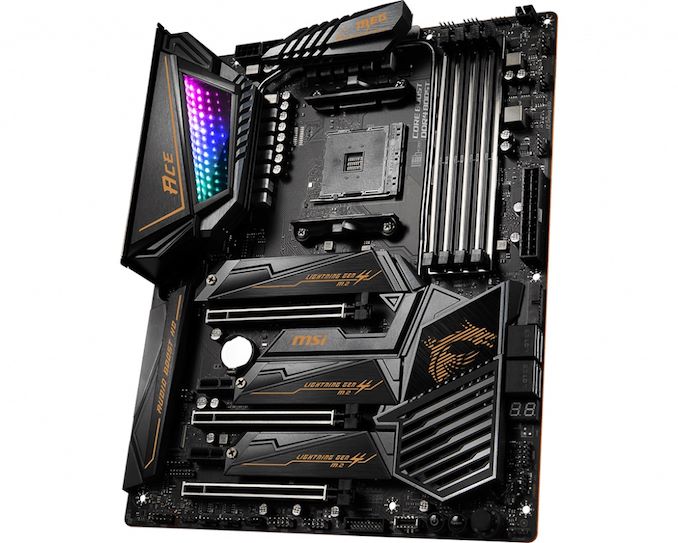
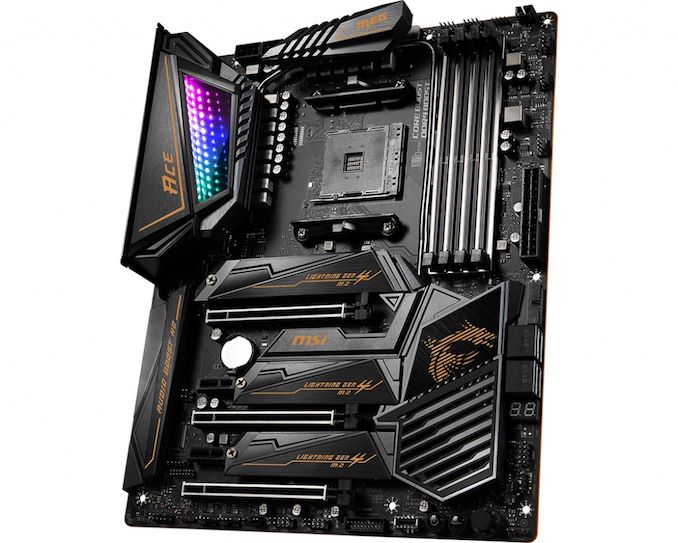
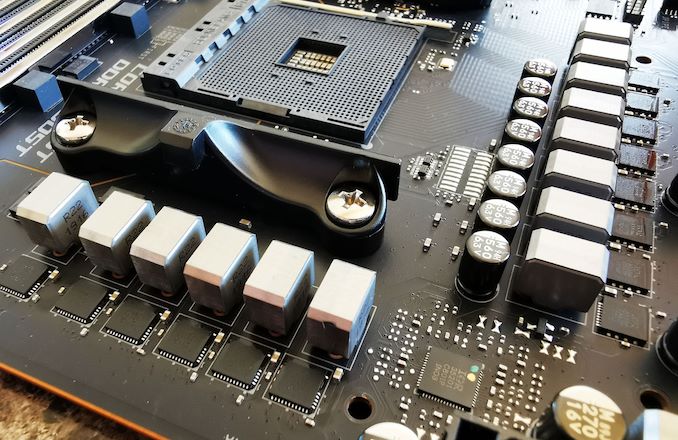
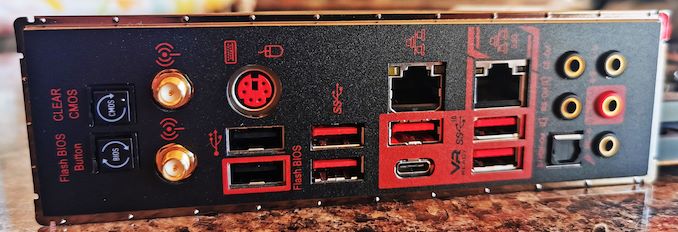
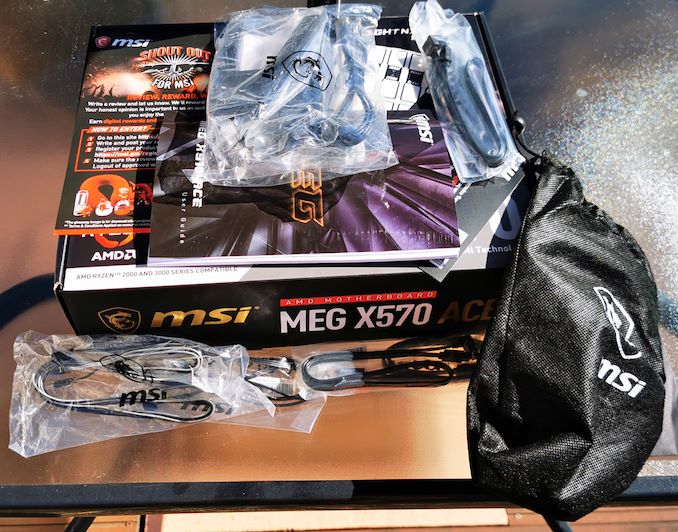








92 Comments
View All Comments
Sparkyman215 - Thursday, July 18, 2019 - link
Why are certain seemingly random portions of the article specifically tagged a certain color? The body <p> tags are #444 but some snippets are set to rgb(68,68,68) (which is #444) in the same <p> tag. I know it literally doesn't matter to anyone but I noticed it and it's weird hahayeeeeman - Thursday, July 18, 2019 - link
Dear Anandtech, not everyone needs PCIe 4.0 and these gimmicky motherboards. Also, not everyone has over 200$ to throw, so please test all new Ryzens on B350 motherboards.Showtime - Thursday, July 18, 2019 - link
Yeah pricing is high IMO. I want to go AMD, but I can't justify spending $200 on motherboard for a $200 CPU. Some people have had to do some work to get the older, cheaper motherboards to work right after the bios update. Guess I'll wait and see. Not like my old Intel is slow.Holliday75 - Thursday, July 18, 2019 - link
I am of the opinion that unless you plan on buying a new PC in the next several years after putting a 3000 based system together then spend the money and get the x570 based board. There are cheaper models to choose from, but the PCI 4.0 support will be very nice to have down the road when GPU's are taking advantage of it. Having to upgrade a motherboard mid-ownership cycle would suck and eat up any savings you and then some by using a lower end board.If you already have one it looks like it works on most boards and the performance drop off is not that bad. In IT you pay now or pay later, but you always pay. I prefer up front to avoid it down the road when it tends to be more of a pain in the arse.
Irata - Friday, July 19, 2019 - link
Definitely agree with your comment.My plan is to get a good X570 mainboard now and use it with a Ryzen 3700x. Once the Ryzen 3000 series is EOL, I want to upgrade to a 3950x which hopefully can be had cheaper then.
Looking at the reviews of PCIe 4 NVMe that are available right now, I see little point in getting one now, but will definitely upgrade to one once Samsung and others offer them.
All of this I would like without having to replace the motherboard.
shabby - Thursday, July 18, 2019 - link
The 3900x works even on a320 boards but only hits around 3.7ghz tops. I honestly don't think these $300+ boards with trick vrm/phases are needed at all, these ryzen chips peak at 4.3ghz with liquid cooling. Even $200 boards should easily 16 cores at that speed.Targon - Thursday, July 18, 2019 - link
The cost of PCI Express 4.0 is the reason for the high motherboard prices. You do get what you pay for when it comes to motherboards.29a - Thursday, July 18, 2019 - link
I almost always buy a super cheap Asrock or Biostar motherboard and never have any issues with speed or stability.pavag - Saturday, July 20, 2019 - link
Maybe those motherboards are prepared for future processors, which need more power.29a - Thursday, July 18, 2019 - link
I agree I came here just to request reviews of cheap motherboards. Also an article addressing all the BIOS settings and detailed explanations on what they do on modern motherboards would be awesome too.